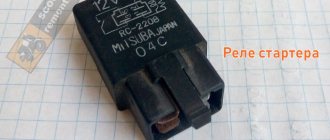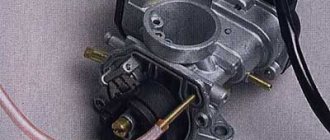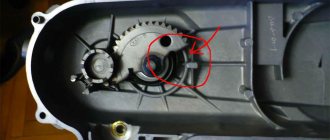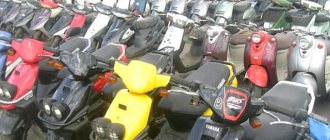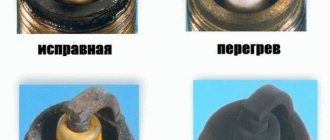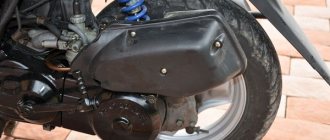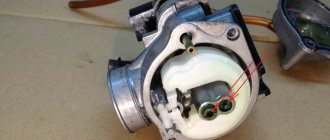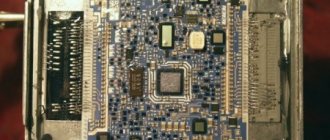First of all, you need to check: the ignition and power systems. Carry out a check in those places that can cause the moped to move. The reasons why the scooter does not start, especially in cold weather, may be the following:
No spark in spark plug
The scooter does not start because there is no spark in the spark plug. In this case, you need to do the following: the spark plug is unscrewed and checked for suitability. Connects to the ignition coil using a wire. Placed on the cylinder. When the crankshaft rotates, the spark at the spark plug is checked. The scooter will not start if there is no spark at the plug, or there is a spark, but it is inconsistent.
Reasons for the lack of spark on the spark plug
Cold weather
The scooter may have difficulty starting in cold weather if there is a problem with the spark plug cap or its connector. In such a situation, the cap is unscrewed from the wire, and the wire is brought 0.3 cm closer to the metal motor element to crank the crankshaft.
A moped can carry current in cold weather. This happens due to the fact that there is contact with the exposed part of the wire and the metal element due to which the scooter starts.
Malfunctions in the power system
A moped may have difficulty starting in cold weather if there is a problem in the power system: lack of fuel or its excess. In this case, you need to check the following elements: gas tank, fuel tap, starting enrichment and fuel pump.
First of all, check the moped's fuel pump
Along with this, it is worth noting that the moped needs to be repaired, and parts should only be disassembled if there is complete confidence that they are faulty. It is best to install only new parts on the scooter, and not used ones, otherwise the engine, when started from the starter, will either work poorly or will not start at all.
What could cause
The reasons why mopeds no longer start may be the following:
- fuel system
- ignition system
- compression
- engine oil.
Each of these categories includes many details, which we will learn about below.
Fuel system
Nothing to burn, or lack of fuel in the combustion chamber, is the main reason why the moped will not start. Below are a number of common breakdowns and ways to fix them.
- Low quality fuel. Diluted gasoline or old fuel will not allow the engine to start. A particularly pressing problem is when the delta or alpha does not start after winter. The fuel in the tank has lost its combustible properties and may not even ignite.
- Faulty fuel valve. If fuel from the tank does not flow into the carburetor, the fault lies in the fuel tap. If you have a scooter, then immediately change the tap, first checking the presence of the supplied vacuum. You can try to clean the faucet on a moped.
- A dirty fuel filter can prevent gasoline from entering the carburetor. The filter must be clean.
- Carburetor. If the moped starts and stalls, there is an 80% chance that the cause is in the carburetor. To clean it, you can use a carburetor cleaner, but the safest thing to do is disassemble it and wash it yourself. The shut-off needle must be free of defects and the fuel jets must not be clogged!
- A clogged air filter is another reason why the moped has difficulty starting. After all, for an engine to operate, it requires not only gasoline, but also air. Remove the air filter and try to see if the moped starts. If it starts, then the problem was in the air filter - clean it.
Moped won't start after winter - check the battery
How to start a moped after winter is a question that in most cases arises from owners who neglected their iron friend in the fall. In other words, they did not preserve it before the onset of cold weather. And since this happened, then it is necessary to start checking and finding out the cause from the very heart of the moped, from the battery.
If you can’t start the moped right away, then unscrewing the battery starter until the crankshaft is completely plugged is a stupid thing. When the engine does not start right away, you should not force it, since it is advisable to save the battery power, it will be useful later.
How quickly the moped will start depends on the condition of the battery. Naturally, lighting the battery through the wires can give a positive result, but it will be less effective than a well-charged own scooter battery.
Therefore, before taking your first ride on an iron horse, it is worth checking the condition of the battery. Better yet, take the battery home and charge it. And after driving under current, make the first attempts to start the moped.
If everything is in order with this, then we look at the spark plugs.
Unscrew the spark plugs. Are they damp and smell like gasoline? This means they are flooded. This can be for two reasons - you filled them or there is a malfunction in the motorcycle.
If you did this, for example, you turned off or started the motorcycle incorrectly, then you can fix it as follows.
Dry the spark plugs, blow them out and heat them. !We do not clean with a wire brush!
Next, put the dry spark plugs in place and try to start the motorcycle. If the motorcycle works, then !hurray! we continue our way.
TIP: purchase and carry a spare set of candles with you; once filled candles can stop working at any time, even if you bought them just yesterday.
Reason and solution
The easiest way to get rid of pops on a carburetor motorcycle is to simply move the needle valve to a different position, changing the degree of saturation of the mixture with gasoline. It is better to entrust this operation to a specialist, since not everyone can fine-tune the carburetor. If there is electronic fuel injection, it is impossible to change the gasoline supply parameters yourself - the control unit will have to be flashed at a specialized service station.
It happens that the motorcycle shoots into the muffler and carburetor - this is often found on domestic Urals and imported choppers with a large cylinder capacity. The problem is a clogged air-fuel mixture at the inlet. To eliminate it, it is worth changing the filters and sealing gaskets, and also checking how tightly the pipes fit to the inlet fittings and whether there are any large cracks in them.
Very often, popping noises appear after replacing the muffler with a non-standard one or cutting holes in it to eliminate resistance to escaping exhaust gases. Particularly unpleasant sounds appear when installing a “direct flow”. The reason is the creation of a strong vacuum, which leads to a lean air-fuel mixture. Powerful imported motorcycles often use an exhaust gas afterburning system, which reduces their toxicity - after removing the standard muffler, its operation becomes clearly audible. To eliminate shots after changing the silencer, you must:
- Reconfigure the carburetor or reflash the control unit;
- Install filters with a different capacity;
- Disable the exhaust gas afterburning system.
On sports motorcycles whose engines run at high speeds, the problem with shots may be related to the speed limiter or crankshaft speed limiter. When a certain indicator is reached, the fuel supply may remain unchanged for some time, while the number of flares is reduced. Accordingly, a huge amount of gasoline enters the muffler, which explodes with a jerky sound, forming a “machine gun burst.” It can be heard especially well when releasing the gas after active acceleration. It is impossible to eliminate such a problem without reducing the life of the engine - you have to change your driving style so as not to irritate yourself and others with unpleasant loud bangs.
It is worth paying attention to the ignition system - missed flashes may be due to its malfunction. Carefully inspect the high-voltage wires - there should be no cracks or peeling of the insulation on them. After unscrewing the spark plugs, check to see if there is a specific deposit on their surface that appears when using low-quality gasoline or when the ignition timing is set incorrectly. If the motorcycle is equipped with an electronic ignition system, the problem can often be solved by reprogramming the control unit. Some motorcycle owners decide to make drastic changes by installing a new control unit with preset sport settings - this solves the problem of shots in the muffler, and also increases engine power and improves dynamic characteristics.
Exhaust pipe clogged with carbon deposits
In this situation, the scooter does not pull at all and stalls.
You need to remove the pipe and check it for ventilation. There may be carbon deposits inside the pipe or some partition has broken off, blocking the exhaust.
You can also check the pipe without removing it from the scooter: at idle, if the pipe is not clogged, the smoke comes out in a pulsation, approximately at the beat of the engine.
And if the pipe is clogged, then the smoke comes out at high speed in a continuous stream. This indicates a reduction in the throughput hole in the exhaust pipe.
Adjusting the carburetor on an Alpha moped. Which is correct?
If one of the parts breaks down, the motorcycle will no longer work smoothly, intermittently, or not work at all. Another thing is setup. You may need it after an accident, winter, or after break-in. Adjusting the carburetor of an Alpha moped is often an almost obligatory maintenance item, especially if the owner has identified problems with it. If your motorcycle stalls, uses too much fuel, or makes abnormal noises, it may mean that the carburetor needs adjustment. How to do this and how to then determine that everything is set correctly? First, it would be a good idea to determine what processes are taking place there.
Checking the piston group
If the compression level in the cylinder is low, the dynamics of the scooter will worsen, or it will stop starting altogether. The cause of the problem may be ring wear, low-quality spare parts, incorrect cylinder boring, or prolonged use of equipment at maximum power.
It is easy to diagnose the problem; you just need to start the scooter using the kick starter. If no resistance is felt when pressing, it means that the pressure in the cylinder has dropped below 7 bar. You can accurately determine compression using a compression meter. Ideally, the device should show 10 bar. But if the pressure is low, repair or replacement of the piston group will be required.
How to adjust the carburetor?
Before adjusting the carburetor of the Alpha moped, it must be started and warmed up. Tighten the screw for the quantity (idle speed) and quality of the mixture until it stops. The latter is necessary so that the engine does not stall. When the engine begins to stall, you should increase the speed of the speed screw. When the engine is ready to stall, you need to unscrew the quantity screw. Now the mixture quality screw follows the moment when the engine reaches maximum speed. If too high, adjust the engine speed screw (idle speed screw). Then you need to spin it until the engine stops gaining momentum.
Now at low speeds the engine can run easily and not stall. Tighten the mixture quality screw until the engine begins to lose speed. The idle speed screw should be set to idle speed. The norm is approximately 1500-1200 rpm.
Checking the ignition timing
If there is a spark, fuel is supplied, compression is fine, but the moped still does not start - the ignition timing may be off.
On 139fmb engines, which are installed on alpha, the ignition timing is not adjustable. It is rigidly determined by the position of the flywheel on the crankshaft. The engine crankshaft on the generator side has a conical surface on which the flywheel (also known as the generator rotor) is tightly seated. The correct position of the flywheel is set using a key that is inserted into the crankshaft keyway.
You can check this visually (remove the generator cover, unscrew the nut securing the flywheel and see if the grooves match). But the groove on the crankshaft cannot always be seen (depending on the specific instance), so there is a more reliable way: buy or borrow a strobe light from someone (many car repair shops have one), unscrew the plug on the generator cover and check that flashes occur at the same time the label || appears in the window.
The service life of a moped depends on maintenance. Care comes down to following the rules recommended by the manufacturer.
The main ones include:
- Testing a new scooter. The first concerns the running-in of a new scooter. The scooter must not be overloaded for the first 1000 km. When driving for a long time, you must stop every 30 minutes to prevent the engine from overheating.
- Correct use in winter. You need to drain the fuel before storing the scooter in the garage for the winter. Remaining fuel can destroy the tank and flood the carburetor. If you plan to use the scooter in winter, you need to change the fuel, check the battery charge, oil level, condition of the filters and tire pressure (it should be about 1.5 atmospheres).
- Correct use in summer. In hot weather, it is important to prevent the scooter from overheating. When driving for a long time at 30 degrees, the cylinders will be constantly overheated. This could cause the belt to break or the engine to break down. You should also not squeeze the throttle for too long, and when stopping, immediately turn off the engine.
- Use quality fuel. Gasoline must be at least 92. On a new moped, you need to change the oil for the first time after a run of 500 km. Subsequent replacement will be required every 1000 km. The first time to change the oil in the rear gearbox is after 200 km, then every 5000 km.
- Replacing the variator belt. This part is considered a consumable item, as it wears out quickly due to the high power load. If the moped stops squeezing out high speed, then the part and its components need to be replaced.
- Carburetor maintenance. The procedure includes a visual inspection for leaks and gasoline consumption levels, checking the condition of the connecting elements and the serviceability of the unit elements.
- Filtration quality control. The filter must be replaced promptly and impregnated with a special product after installation. This is necessary for high-quality air purification. Dirty air reduces the life of the motor.
How does a carburetor work?
On one side the air comes in, that’s where the air filter is attached, and on the other side the cylinder comes in, and that’s where the mixture comes out. At the bottom there is a float chamber, a jet and a tube. When the piston moves down, it sucks air from the air filter. The speed of this air is quite high, which causes a vacuum: the atmospheric pressure increases, and because of this, gasoline begins to flow from the float chamber through the nozzle and the emulsion tube. The fuel mixes with the air and actually breaks down into dust. Moving on, it calmly flies into the cylinder. With such work, it may not be necessary to adjust the carburetor of the Alpha moped (110 or 72).
If the gasoline level changes, it will flow out through the drain pipe. This happens due to the overflow of the float chamber: floats, shut-off needle with a rubber tip and hole. When gasoline rises, the float blocks the flow of gasoline. There is a shaft at the top where the spool with a needle runs, and a cable to the throttle handle stretches to it. The needle enters the emulsion tube and nozzle. With gas, the space increases and the amount of mixture changes. This is controlled by the mixture quality screw. The idle jet with the screw facing outwards is intended for dosing the mixture. This is the second screw.
Motorcycle won't start when cold
- Trying to start the engine in cold weather? You'll have to work hard to "wake up" him. The fuel mixture in the combustion chamber ignites only at a certain temperature, and engine oil becomes very thick in cold weather. We check the condition of the oil and depress the clutch during the starting process.
- Was the equipment stored in a poorly heated garage during the winter? In spring, rust appears on its components due to high humidity. Before you go on your first spring trip, the rust from the ignition parts must be removed.
- Difficulties with cold starting also occur in the warm season. If the motorcycle does not catch (does not start) after a long period of inactivity, you need to check the condition of the carburetor or increase the fuel level in the float chamber.
How to start a moped after winter using ether
How to start a moped after winter , this is quite easy to do with the help of ether, provided that the iron horse has not been struck by another, larger breakdown. For this procedure, it is necessary to remove the air filter cover and spray a large volume of ether directly onto the filter part. Then quickly close the lid so that the ether does not evaporate.
Well, start trying to start it, if you couldn’t start the engine the third time, then you need the help of a good mechanic and the only way is to the service station. Well, if the iron horse “made an attempt” to sneeze, you can repeat this procedure.
At the same time, it is worth remembering that if in the fall the moped started up and worked flawlessly, it means that all of the above methods will help start up the iron friend in the spring. Well, if your moped had problems running in the fall, then you shouldn’t waste time, you need to take it to a self-service station.
Carburetor clogged
The symptoms of the problem are the same as in the previous case - you can start the moped, but then it stalls. That is, there is a spark, there is gasoline, but the moped does not start. In order to check whether the carburetor has broken down, you need to check how gasoline flows from it into the cylinder.
Take the spark plugs and wet their contacts with gasoline. Then screw the spark plug being tested into the cylinder and try to start the moped. If the bike starts this way, it means the carburetor will have to be repaired.
If you are on the road and need to quickly get to your destination, you can clean the supply hoses by blowing them with a pump. If this does not work, then you need to completely clean the carburetor.
